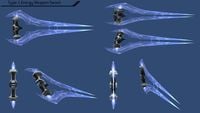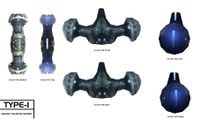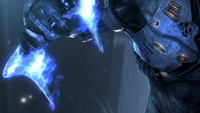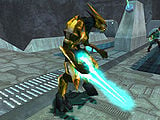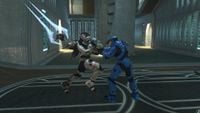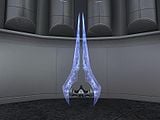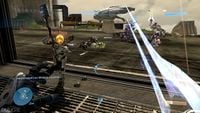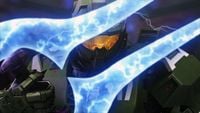Energy sword: Difference between revisions
From Halopedia, the Halo wiki
Sith Venator (talk | contribs) |
Sith Venator (talk | contribs) |
||
| Line 164: | Line 164: | ||
*''[[Halo: Escalation]]'' | *''[[Halo: Escalation]]'' | ||
*''[[Halo 2 Anniversary]]'' | *''[[Halo 2 Anniversary]]'' | ||
**''[[Terminal/Halo 2 Anniversary|Terminals]] | |||
==Sources== | ==Sources== | ||
Revision as of 13:16, July 5, 2014
- "A noble and ancient weapon, wielded by the strongest of Sangheili, requires great skill and bravery to use, and inspires fear in those who face its elegant plasma blade."
- — Supreme Commander Thel 'Vadamee [1]
The Type-1 Energy Weapon/Sword, commonly known as the energy sword, is a traditional Sangheili close-quarters weapon.[2][3]
Overview
Background
The energy sword is the signature weapon of the Sangheili and has been their chief weapon of nobility since its creation during one of the Ages of Discovery.[4] The Sangheili pride themselves on their skills with the weapon,[5] which they regard as holy,[6] and believe that it is better for a Sangheili to fall on his sword to redeem his honor than to die dishonorably.[7][8][6] The Sangheili are very strict on who can be trained in the art of swordsmanship; in civilian life only aristocrats are permitted to wield energy swords.[9] Sword wielders are not eligible for marriage, though they may breed with any female they choose, married or otherwise, to ensure successful transmission of "swordsman" genes.[10][3]
Within the Covenant military, use of the energy sword is not restricted to aristocrats.[9] Sangheili Minors are generally not permitted to wield the sword because of the high regard in which it is held,[6] though exceptions have been witnessed.[11][12][13] It is unknown whether this extends to Majors, as at least one has been witnessed using an energy sword.[13] Ultras, Zealots, special operations and stealth troops, and honor guardsmen commonly use energy swords. Contrary to the original Covenant, Jul 'Mdama's reformed sect seems less stringent about traditional wielding protocol; as such, members of the Storm class (analogous to Minors) are quite often seen wielding energy swords.[14]
Design
The energy sword's design is seen as the logical evolution of an ancient lineage of traditional Sangheili weapons, most notably the twin-scythe and the curveblade;[15][3] superficially, the twin-scythe's influence on the energy sword's design is unmistakable.[16] Modern energy swords are manufactured by the Merchants of Qikost, a prominent group of arms makers from one of Sanghelios' moons.[9] The energy sword consists of a curved hilt, which houses an energy storage and generation device, as well as the blade projector; that forms a blade of superheated plasma, stabilized by two small magnetic field generators built into the handle of the weapon — this forms and contains the oval shaped, ionized blades for which the weapon is recognized.[2] The weapon is powered by a small battery that supplies power to the plasma generation device and magnetic field generators which generate and contain the plasma needed to form the blade.[17] The battery's energy is reduced for each successful strike. Each strike from the sword will drain the battery by 10% of its maximum energy output. Once the battery power is fully depleted, the sword will deactivate unless recharged. The horizontal hilt forces the wielder to use a punching motion to stab rather than the thrusting motion of most knives and swords.
Mass-produced energy swords feature a roughly "W"-shaped hilt and have little variation in blade design. Specifically, some models have more rounded blades in lieu of the more common angular style. However, more drastic variations exist. For example, Arbiter Ripa 'Moramee's matching pair of custom-designed[18] swords had basket-style hilt guards and radiated a high degree of ionized plasma,[19] whereas most energy swords contain the blades' plasma with greater efficiency. Members of the Commando Unit wield blood red-colored energy swords which (ironically, despite their color) burn hotter than more common models.[20]
The energy sword contains a failsafe mechanism that can permanently disable the weapon if the Sangheili wielding it drops it.[21] When dropped, the failsafe engages by deactivating the magnetic field before dispersing the plasma. The plasma then consumes the handle and thus destroys the weapon.[22] The failsafe is included to prevent enemy infantry from acquiring the weapon and using it, and gives insight to Sangheili tactics.
Combat application
The Type-1 Energy Weapon is extremely powerful in close-quarters combat. A single strike can even penetrate the energy shield systems, armor, and flesh of a Spartan or a Sangheili. This is due to the design of the weapon, which utilizes ionized gas rather than traditional shaped, solid matter - because the energy sword lacks any solid material in which to hold, or impale anything, the sword does not cut or carve in the traditional sense, but rather boils anything it comes into contact with.[17] This allows the weapon to pass through any type of material, including the toughest metal, with ease.[23][24]
Injuries caused by the weapon are often gruesome. Stabs wounds by the energy sword are, in most cases, fatal — as the blade passes through the body, the organs and tissues are cauterized by the extreme temperatures produced by the blades.[25] Body fluids in the area of the stab wound are flash-vaporized upon contact; organs within the area of the stab wounds can suffer life-threatening damage dependent upon which organs are struck. The effects of fluids trapped in organs or arteries and the expansion of heat could lead to ruptures or small explosions, causing additional damage to the victim. Because of the sword's sheer destructive power, dismemberment is another common form of fatality to victims, ranging from decapitation[26] to bodies being sliced in half.[23][27] Loss of limbs is a common injury.[28] Despite the weapon often cutting straight through its target, it is not uncommon for a body impaled on an energy sword to remain suspended (if briefly) on the blade, perhaps due to variable magnetic field strength. The sheer destructive power of the sword makes it a weapon to be feared on any battlefield and is known for its physiological effects on human soldiers.[17]
Gameplay changes
Changes from Halo: Combat Evolved to Halo 2
In Halo: Combat Evolved, the energy sword has a cyan glow, a far less defined edge and makes a dull clunk when striking an object. It is only used by Stealth Sangheili and Zealots. The player cannot wield the energy sword, due to a failsafe mechanism that vaporizes the weapon when it is not released properly (e.g. being dropped upon death) by the sword-wielder.
In Halo 2, the energy sword is blue with purple undertones, with electrical energy crackling on it when the blade is activated. The white glow seen in Halo: Combat Evolved is also replaced with a more glass-like transparency. In the campaign, it is only used by higher-ranking Sangheili, such as special operations units, Ultras and Zealots, though players can now wield the sword. The sword in campaign has a battery and can only be used effectively against a limited number of enemy forces before the battery runs out. The sword is usable in multiplayer with an infinite battery power. The energy sword has two modes of attacking; a lunge attack and a swing attack.
Changes from Halo 2 to Halo 3
In Halo 3, the sword has more of a light cyan tinge, similar to its appearance in Halo: Combat Evolved, but still has a tint of purple near the handle. It also has an angle near the handle, whereas in the two previous games it was curved. Players are now able to parry with the Sword. The power exerted by the swords hitting each other will drain both players' shields, but will not kill them unless one makes the fatal blow. The sword's lunge attack has been reduced for balancing purposes. Aside from these changes in design and functionality, the power of the sword remains unchanged. In multiplayer, the sword now has a limited battery supply.
Changes from Halo 3 to Halo: Reach
In Halo: Reach, the sword resembles closely to the design used in Halo: Combat Evolved, albeit darker in color. When activated, the sword is capable of lighting up the surrounding area. When unused, the sword rests differently on the SPARTAN and Sangheili character models. The energy sword appears to have been balanced out compared with its earlier incarnations, having a slightly faster swing than its Halo 3 incarnation, its lunge attack now does the same damage as a normal swing, the range has been reduced, and can now be blocked by a well-timed normal melee. Players can no longer lunge immediately after a normal swing. The energy sword also has its own assassination animations when used against Elites or Spartans, replacing the Spartan Combat knife and the Sangheili energy dagger; these assassinations do not deplete the sword's charge, nor do they count toward the weapon spree medals Sword Spree, Slice 'N Dice or Cutting Crew. Elites also hold the sword back more than a Spartan when used as an active weapon. When a player is playing as an Elite and uses the Energy Sword as a primary weapon, the camera will lower a bit; this is due to the Elite hunching down. Finally, parrying does slight damage and can kill a player.
Changes from Halo: Reach to Halo 4
Contrary to Halo: Reach, Halo 4 does not feature the possibility to block a sword lunge with a simple melee. Killing an opponent with an energy sword no longer rewards the player with a Pummel medal, it is instead replaced by the Sword Kill medal. The battery is also drained with every hit, so it's far less viable against Hunters and other powerful enemies.
Tactics
There are two ways a player in Halo 2, Halo 3, Halo 4 and Halo: Reach can attack, the first is to lunge with the energy sword. With this, the player lunges forward at the other player. However, this only works when the aiming reticule is lit red, indicating that the opposing player is within range. The second attack is the simple melee, this performs a quick horizontal or overhanded swipe.
Campaign
- In Halo: Combat Evolved and Halo 2, use the advantage that the Elites need to be close to one to damage the player's energy shield. On higher difficulties, use the Noob Combo to eliminate the energy sword-wielding Elites. With this tactic, one can kill a Elite Honor Guard with a single Plasma Pistol easily in Halo 2, even on Heroic or Legendary.
- It is extremely ill-advised to use the sword against Grunts, Jackals, Drones, or Engineers. Due to the low-threat nature of these enemies they can easily be killed with any other weapon, or even a simple melee.
- The sword is extremely valuable against Elites, Brutes, and perhaps Hunters.
- When facing sword-wielding Elites, a sound tactic is to jump and lunge attack them. This will kill them quickly and save one's shields or even life on higher difficulties.
- In both Halo 2 and Halo 3, the energy sword is one of the best anti-Flood weapons, as it will destroy Flood Combat and Pure Forms in one strike (although if an infected Elite still has its shield, it may take two swipes, depending on the difficulty setting).
- When fighting against the Flood, an attack with the energy sword will deplete the battery by a very small amount (about 3%) due to their soft tissue, making it useful for extended durations. Against Infection Forms, no power is drained.
- The energy sword in Halo 2 and Halo 3 can be used to destroy the corpses of Flood Combat Forms so that they cannot be re-infected by Infection Forms. However, the cutting process does drain battery power. Although, any weapon's melee attack can be used to destroy combat form corpses if used enough times, even a depleted energy sword hilt.
- In Halo 3 the energy sword is very hard to come by in the campaign outside of Floodgate, Cortana, and Halo. The player can obtain an energy sword by betraying an Elite ally on The Covenant by sticking him with a grenade (if Mythic is turned on, the Elite can survive a Plasma Grenade and his energy sword can be taken) or by draining the Arbiter's shield during combat (this happens more frequently on higher difficulties). If the player does so, it is a very good weapon against Brutes, although the battery will deplete very quickly.
- In Halo: Reach the sword will knock out the shields of any Elite in one hit on Legendary, and following up with a headshot means that the sword's battery won't deplete. This is an effective strategy on Long Night of Solace, The Package and Pillar of Autumn. The sword is also incredibly effective against Hunters on all difficulties, as a hit anywhere stuns them and a single swipe to the back kills them. Opportunities for this in campaign are limited to The Package, but it is a useful tactic in Firefight.
Multiplayer
- The sword is easily one of the best close range weapons to use in Halo 2. The best tactic is to lay into an enemy player with your secondary weapon getting closer, then when within range perform a quick swipe with the sword for the finishing move. However since there is no way of telling which player has the sword, or no sound way to stop it, it has often been labeled as a cheap tactic.
- Using Active Camouflage with the sword in Halo 2 is not a wise thing to do as the sword in Halo 2 is still visible with it active. In Halo 3 however, using the sword with active camouflage is a sound tactic as it will now cover the sword when picked up.
- In Halo 3 the sword lunge is shorter, and the player cannot perform a quick strike. In addition, the sword's handle is now visible on the character's leg. In order for the sword to be most effective the player must lure a player into a trap where the sword will become effective; camping with the sword in a corner and waiting is the best way to use it to its fullest extent. As a special note, there is a range difference between the B button melee, and the right trigger lunge. The lunge has the maximum range, whilst the B button seems to only work at 1/2 to 3/4 the range. This is, most likely, for balancing, as the B button swings the sword at a much, much faster rate.
- If the enemy controls the sword room in the Halo 3 multiplayer map The Pit, stick to the outer wall. The range is just short of the wall and if you're lucky your opponent will lunge and miss, giving you the perfect opportunity to kill him or her.
Advanced tactics
- It is possible to dodge a lunge from the energy sword. To do this, one must move quickly to the right when facing the lunging opponent, towards the hand which does not hold the sword. Conversely, to prevent your target from dodging your lunge, simply jump; jumping reduces all chances of missing or being dodged by an opponent.
- In Halo 3, a new feature has been added so that players can parry their opponent's sword by meleeing or lunging at the same time. If you pull the right trigger right before the other person makes contact, a parrying electric clash is produced, but you do lose some or all of your shield. However, when you get down to no shields, a sword clash will not affect your health, though your screen will flash bright red. This is sometimes known as "fencing". If you time it well enough the sword fight can last indefinitely. Because it is faster, using the melee attack instead of the lunge is required in this scenario, even for the first hit.
- Jumping can make the energy sword much more fearsome, brutally effective and accurate. Jump and point your reticule down, waiting until it turns red to lunge at the opponent. In Halo: Reach, the armor abilites Evade, Sprint, and Active Camo are the most effective to use with the Energy Sword, depending on individual playing style and situation.
- In Halo 2 avoiding a sword lunge is extremely difficult, if timed correctly and with a bit of luck, side stepping in the direction of the enemy players free hand may save your life, however this is often difficult. In Halo 3 avoiding the sword lunge can be done by using either a Brute Shot or a Shotgun, there is still some difficulty in pulling it off, but the odds of killing an enemy player using the Sword is much greater than on Halo 2.
- An extremely useful tactic against other players wielding swords, is to, rather than hitting B twice for two quick melees, is to strike first with a melee, and then finish them on with the lunge. This tactic is much faster than two melees.
- In Halo: Reach, there is a new technique in which a player may block a sword lunge with any weapon they are carrying at the time. This is done by simply meleeing the incoming attack and stopping the attack with a well timed strike. Both players will receive possibly fatal damage from the clash, with the non-sword user taking more damage. This can be used to counter a sword user in close range if you damage them with your gun first.
- Also In Halo: Reach a useful tactic is to use the Hologram armor ability and jump back just before the sword wielder lunges, your opponent will hit the hologram instead of you. This gives you time to escape or retaliate.
Trivia
- The shape of the energy sword is very similar to the real-life combat weapon, the katara. It was a South Asian weapon and status symbol, similar to the energy sword's symbolization of status among the Elites.
- The energy sword was originally going to be usable in Halo: Combat Evolved, but was cut when the game became a first-person shooter. [29]
- In the Halo 3 Vidoc Et tu Brute? there is an unfinished animation depicting a Jiralhanae Chieftain wielding an energy sword. This is, however, never seen in the hands of Jiralhanae in the final game.
- The Fable 2: Limited Edition comes with "Hal's Sword", a crystal blade shaped like an Energy Sword for in-game use, to coincide with the use of "Hal's Armor", which resembles MJOLNIR armor. [30]
- A depleted Energy Sword hilt can still be used offensively. While the damage varies, it has a higher melee rate than any weapon, allowing the player to barrage an enemy with many hits. Once the hilt is swapped for another weapon, however, it cannot be picked up again and often disappears entirely.
Gallery
- Type-1 Sangheili Energy Sword.png
The Energy Sword in the Halo: Reach Multiplayer Beta.
- HReach-EnergySword-Profile.png
A profile view of the Energy Sword in Halo: Reach on Halo Waypoint.
- HReach-EnergySword-SideRender.png
In-game side view of the Energy Sword in Halo: Reach.
- Energy Sword Halo3.png
The Energy Sword as it appears in Halo 3.
- ArbiterHWSword.jpg
A study of Arbiter Ripa 'Moramee's custom Energy Swords in Halo Wars.
- H2-CovEliteEnergySword.png
The Energy Sword as it appears in Halo 2.
- Black Sword.JPG
Another view of the Energy Sword from Halo 3.
- 1221845548 Elites duel wielding energy swords.jpg
Rtas 'Vadum and Kusovai dual-wielding Energy Swords during a training exercise.
- 79621875-Medium.jpg
Two Spartans parrying in the air on Foundry.
A smaller, more compact variant of the standard Energy Sword called the energy dagger that is used for Assassinations.
An Energy Sword as it appears in the Halo: Reach Beta.
An Energy Sword's crosshair as seen in the Halo: Reach Beta.
- H4-MP-Grifball-EnergySword-HUD.jpg
The Energy Sword being used in the Grifball gametype in Halo 4.
John-117 wielding an Energy Sword against Thel 'Lodamee in Halo Legends: The Package.
A red-colored Energy Sword variant being used by active camouflaged Special Operations Sangheili.

|
Browse more images in this article's gallery page. |
List of appearances
- Halo: Combat Evolved (First appearance)
- Halo: The Flood
- i love bees
- Halo 2
- Halo Graphic Novel
- Halo: Ghosts of Onyx
- Halo 3
- Halo: The Cole Protocol
- Halo Wars: Genesis
- Halo Wars
- Halo: Helljumper
- Halo 3: ODST
- Halo Legends
- Halo: Evolutions - Essential Tales of the Halo Universe
- Halo: Blood Line
- Remember Reach
- Halo: Reach
- Halo: Fall of Reach
- Halo: Combat Evolved Anniversary
- Halo 4: Forward Unto Dawn
- Halo 4
- Halo: Spartan Assault
- Halo: Escalation
- Halo 2 Anniversary
Sources
- ^ Halo 2: Special Collector's Edition Manual
- ^ a b Bungie.net: Halo Reach Ordnance Guide: T1 EW/S
- ^ a b c Halo Waypoint, Energy Sword
- ^ The Covenant Hall of Murals
- ^ Halo Graphic Novel page 12 - 14
- ^ a b c Halo Encyclopedia page 127
- ^ Halo: The Cole Protocol page 53
- ^ Halo: The Cole Protocol page 141
- ^ a b c Cite error: Invalid
<ref>tag; no text was provided for refs namedessential - ^ Bestiarum Sangheili section
- ^ Halo 2, Another Day at the Beach
- ^ Halo Wars, introductory cinematic
- ^ a b Halo Legends, The Package
- ^ Halo 4
- ^ Halo 4: The Essential Visual Guide, page 92
- ^ Halo Legends: The Package
- ^ a b c Halo Encyclopedia page 335
- ^ Halo: The Essential Visual Guide, page 10
- ^ Halo Wars
- ^ Halo: Evolutions - Headhunters
- ^ Halo: First Strike page 74
- ^ Halo: Combat Evolved
- ^ a b Halo: The Cole Protocol page 84
- ^ Halo: First Strike page 72
- ^ Halo: Evolutions Midnight in the Heart of Midlothian page 91
- ^ Halo: Evolutions Midnight in the Heart of Midlothian page 101
- ^ Halo: Ghosts of Onyx page 360
- ^ Halo: The Cole Protocol page 30
- ^ Halo: Combat Evolved, E3 2000 Announcement Trailer
- ^ Joystiq: Fable 2's Spartan armor and energy sword pictured
|
| |||||||||||


